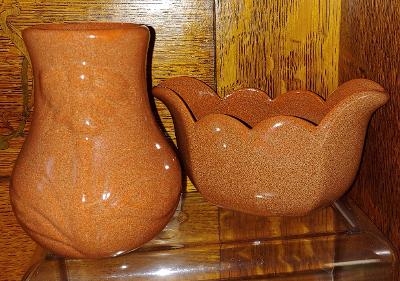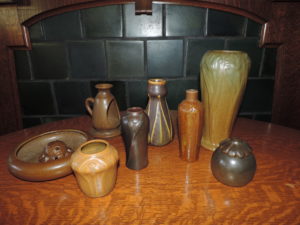An early list of brown glazes includes: Light Brown, Medium Brown, Dark Brown, Golden Brown & Claret Brown
There were many shades of brown used in the early pottery designs. The bowl on far left and the ring-handle candle holder behind it, have affectionately been called the color of “tobacco spit” by one well-known collector in Colorado. The #310, in front, I refer to as almost butterscotch. The #836 in the middle is very dark brown, with flower of 6 petals. The middle piece, #854 dated 1915, has touches of yellow, as does the #376 “Stars & Stripes” design, which also has some matte glaze and some gloss glaze on the same vase. The tall #503 is brown with green over spray – but not the brown & green of Mountain Crag Brown Glaze, shown below. The pieces are all dated from 1905 to ’20 for 1920; except for the far right #879 Dark Brown Potpourri, which is thought to be from the teens.
1st PHASE & 2nd PHASE RUSSET MATTE GLAZES
Jeff Stevenson, son of the Stevenson family who owned VBPCo from 1969 until its closing, developed the Russet glazes. From his own recollections, “For my first foray into new glaze development, my dad requested an earth-tone matte glaze. This led to the introduction of the Russet glaze in 1978. There are actually two different versions of the Russet glaze. At some point, one of the glazers accidentally poured a little of the Midnight glaze into the Russet glaze vat. We decided that the resulting glaze, somewhat darker in color, was more attractive than the original Russet, so I modified the recipe to mimic the mistake, and that became the new Russet glaze. Discontinued in 1984.”
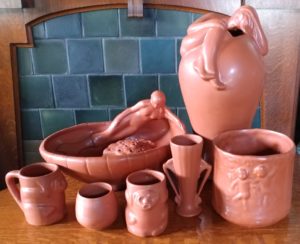
Back row: #899 Siren of the Sea; #9 Despondency; Front row: #Monkey Mug; Fred Wills Original; another Monkey Mug; 2-Handled Vase,
Mid-Century Stock #264; #778 Cherubs
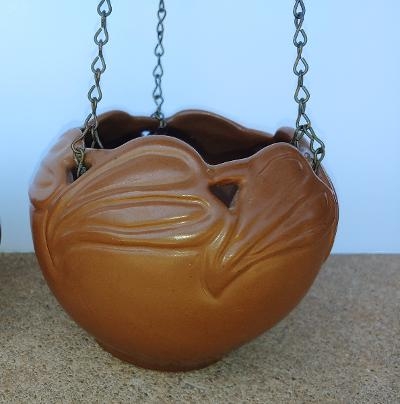
designed by Anne Gregory Van Briggle in 1910;
Reticulated with hanging chain as Mid-Century Stock #847H
SUNSET GLOSS GLAZE – introduced late 1970s
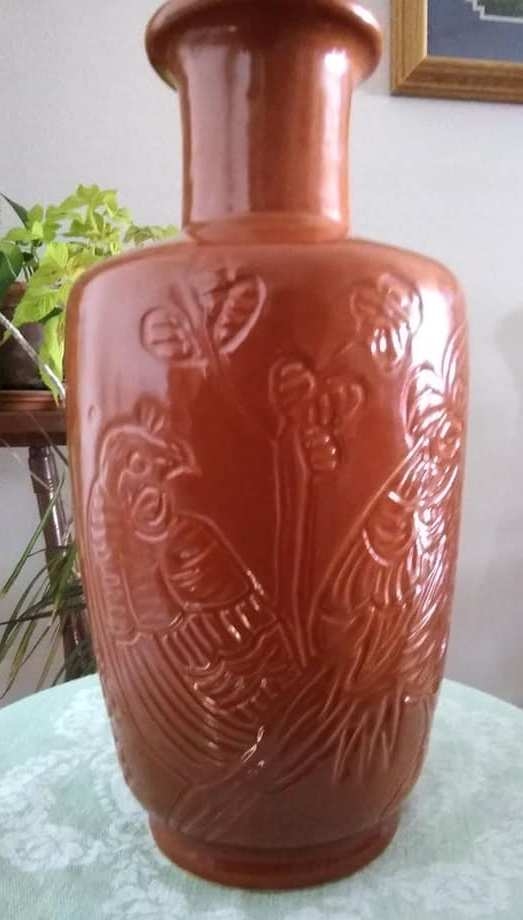
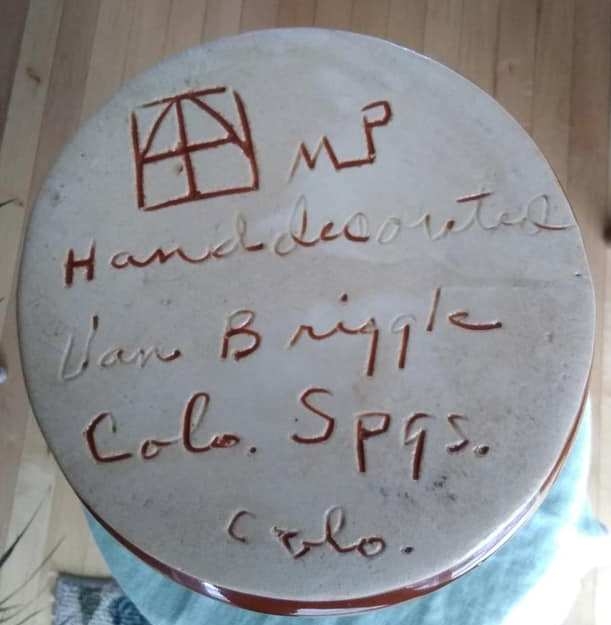
Photos are courtesy of Christopher Worth, private collector. Many thanks to him; we have been able to document this glaze & stunning work by the etcher Marge Pope!
Jeff Stevenson created this rare and elusive glaze, named “Sunset” in the late 1970s. For whatever reason, the glaze was in use only for a short period.
DARK & LIGHT BROWN GLOSS GLAZES – introduced 1980s
Jeff Stevenson wrote of the brown gloss glazes that preceded his employment in 1969, “I’ve seen brochures from the 1960s that refer to a brown glaze called Honey Gold, but I don’t think we used that term while I worked there, and the photos I’ve seen of Honey Gold pieces lead me to believe that that glaze was modified in the late 60s to the brown and dark brown that were in production when I started at Van Briggle in 1969. The gloss glazes were sometimes referred to as “Volcanic Ash” glazes. I think this was mostly for marketing purposes, although their recipes did include some bentonite, which is a clay derived from the decomposition of volcanic ash.” Due to crazing problems, the brown and dark brown glazes were discontinued around 1978. In the 1980s (possibly 1984), Stevenson developed a new craze-resistant gloss brown glaze that remained in production for several years. (See more about Stevenson’s narrative of his work at VBPCo on this website, as the Featured Article.)
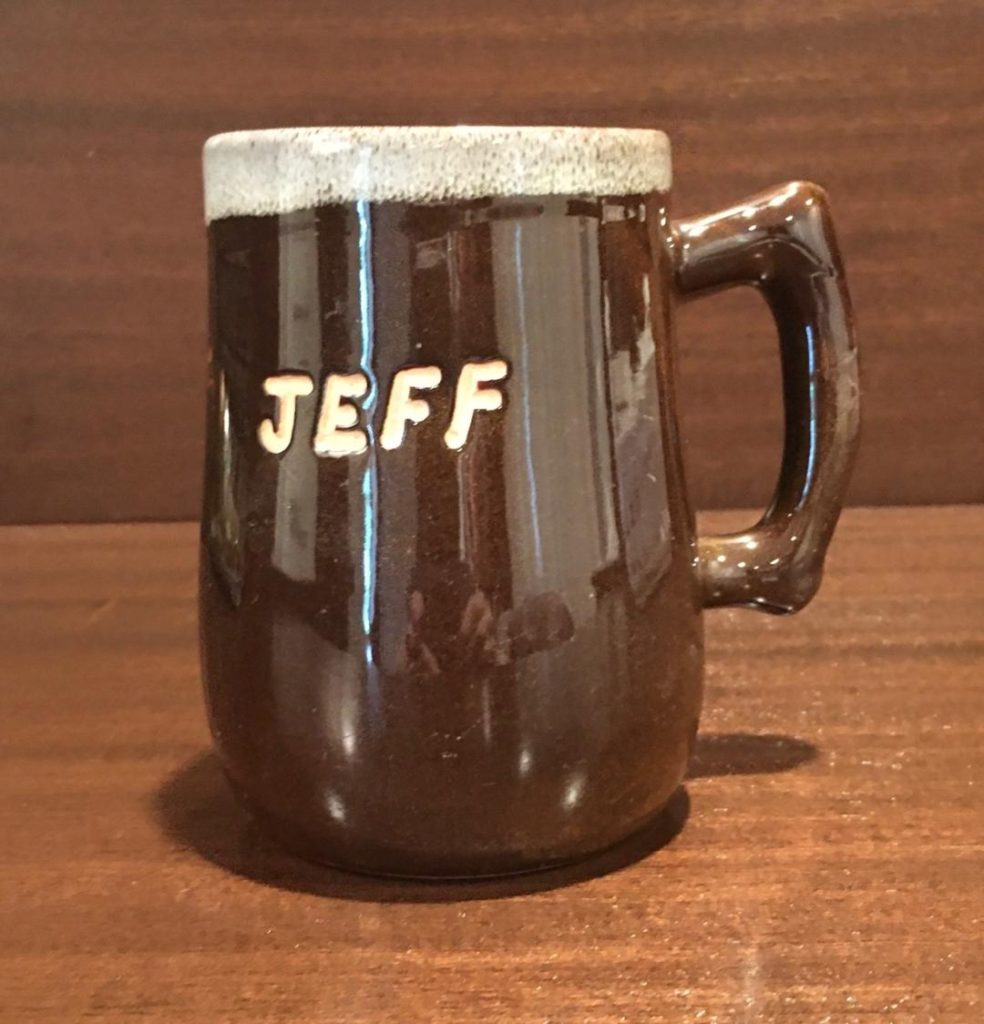
Jeff Stevenson’s Mug
Mid-Century Stock #6
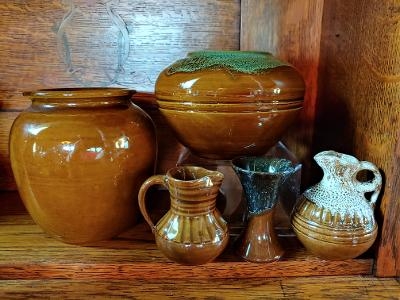
Originals by Tom Wohlford; Fred W. Wills, son of Fred Wills;
Lower three all by Fred Wills
MOUNTAIN CRAG BROWN – introduced in 1920s
First advertised as “the browns and greens found in a mountain crag!” This has also been described as a honey brown with green over spray. Later, the name was inadvertently recorded as Mt Craig; and remained as such until the early 1920s literature was located, showing it originated as MOUNTAIN CRAG BROWN!
Produced during the 1920s until the Flood of 1935, when the formula was lost. A potter who remembered the formula, made one batch of Mt. Crag Brown in the 1950s; and recalled that the pottery owner advised him not to make another!
GOLD ORE GLAZE – introduced in 1956
If you have not seen the Gold Ore Glaze pieces by Van Briggle Pottery; they are somewhat difficult to find. Produced in 1956 for only a few months, the pieces are limited in numbers. They do occasionally pop up at antique shows and sales, but are more often than not unidentified. The clay color showing on the bottom is a beige-color similar to other pieces known as “Anna Van” produced by Van Briggle with a tan, smooth clay during the 1955-1968 period.
A Colorado Springs Gazette Telegraph 1956 article states “SOMETHING NEW…Visitors to the Van Briggle Pottery have long been interested in such things as ‘throwing on the potter’s wheel’ and the huge kilns in which pieces are baked, but this year they’ll see something new – the dipping of pottery pieces into a solution containing gold. After being dipped the pieces are glazed.” The article continues by saying that powdered gold ore from Cripple Creek Gold Mines is incorporated to give the final product a speckled effect.
Several different Van Briggle designs have surfaced, and most bring high prices through online auction, due to the novelty of the glaze. One report of a Gold Ore Despondency has been documented; however, most of the pieces are of small to medium size.
Several different bottom markings have been noted. Some pieces will have “Gold Ore Glaze Made in Colo Spgs.” on the bottom – with or without the addition of the words “Van Briggle”; others will have a “G” within an “O” indicating Gold Ore, and “by Van Briggle Colo. Spgs.”
In today’s market – obtaining a Van Briggle Gold Ore Glaze just might be the easiest way to own your piece of gold!
